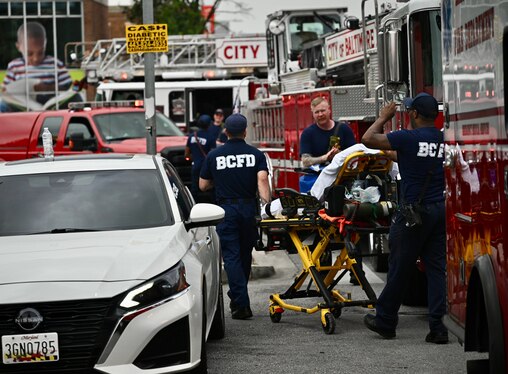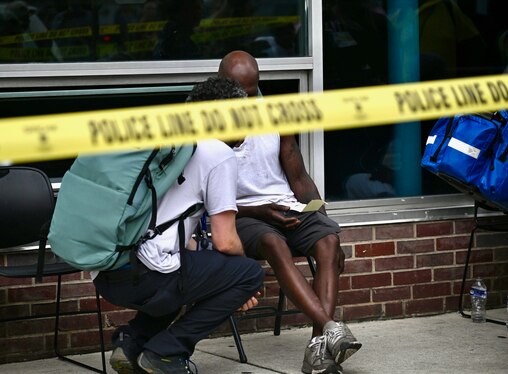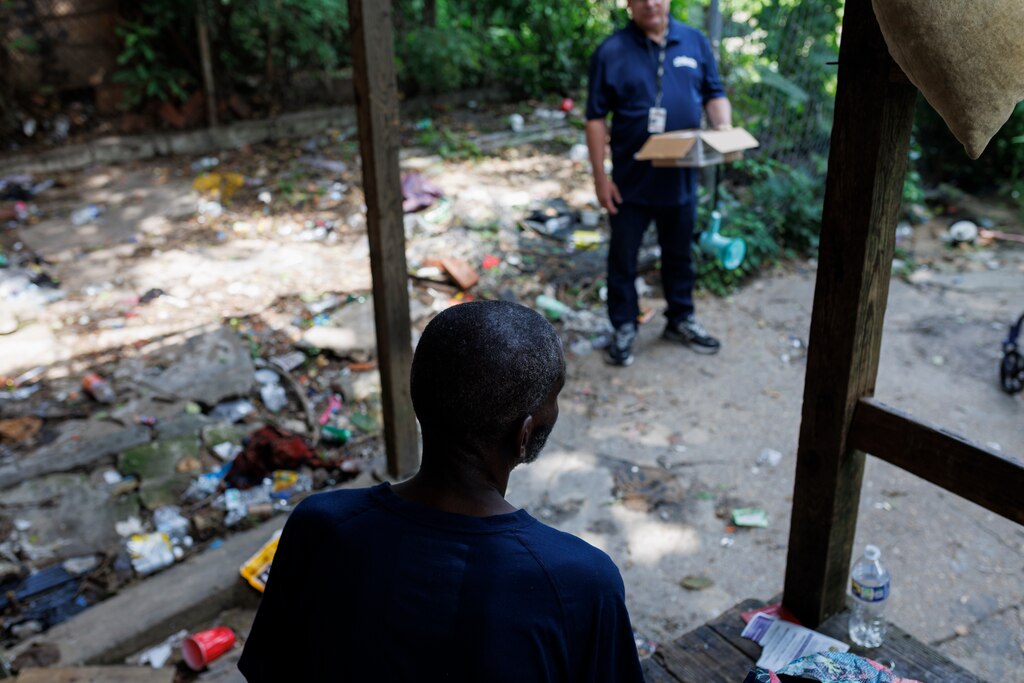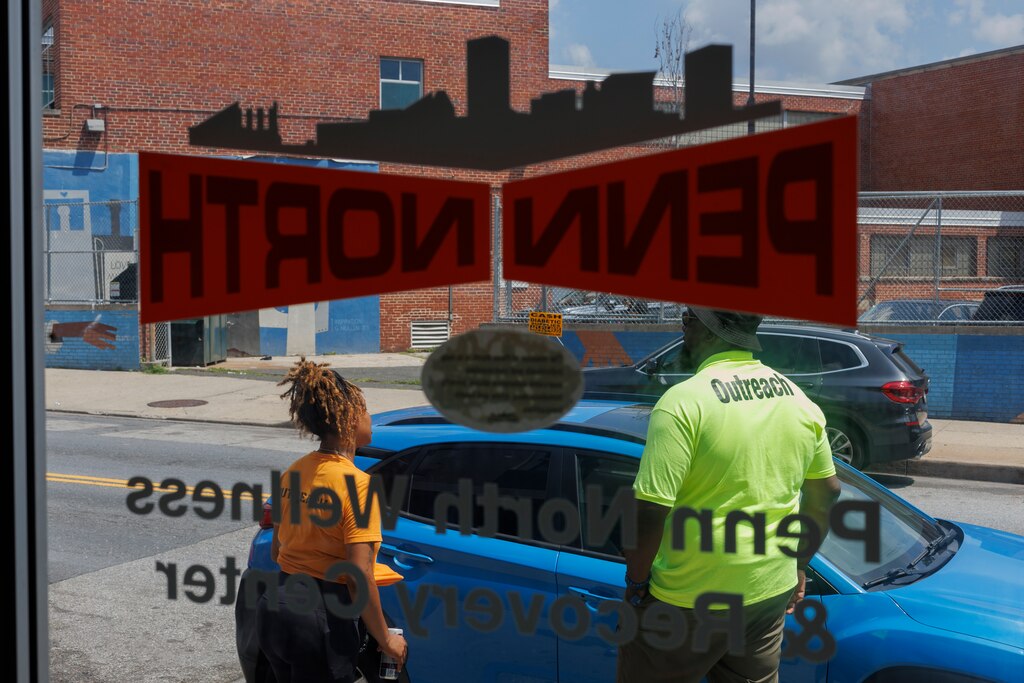The morning after a mass overdose in Baltimore’s Penn North neighborhood, the Pennsylvania Avenue branch of the Enoch Pratt Free Library had become a central point for the city’s outreach team. Community advocates set up tents at the nearby intersection to hand out the overdose-reversal drug naloxone.
“You trying to get Narcan and all that?” Vernard Nelson called out to people passing by.
“Yeah,” a 55-year-old woman replied. “You got any food?”
Nelson, the overdose response director for Penn North Recovery Center, had run out of snacks by that point, but he had plenty of other items to hand out. He packed some Narcan, fentanyl test strips and brochures in a plastic bag.
At least 27 people were taken to hospitals for overdose treatment as of Friday morning, authorities said at a press conference.
They were taken to hospitals across the city, Baltimore Fire Chief James Wallace said. Seven are in critical condition and 15 are in serious, but not life-threatening, condition. There have been no fatalities so far, officials said.
First responders flooded the Penn North neighborhood shortly after 9 a.m. Thursday to find more than a dozen people in need of aid. The Baltimore City Health Department closed half a block to treat people outside the Pratt Library branch, which remained closed on Friday.


City and community workers scoured the neighborhood with boxes of naloxone and fentanyl test strips. The mayor’s office is coordinating as workers continued to canvas West Baltimore on Friday and hand out supplies.
Dozens of people were milling about the intersection near Penn-North station Friday morning, many still reeling from the events the day before.
“It gives you something to think about,” said Stephen Johnson, standing on the corner where he had watched people collapse yesterday.
Read More
When his sister saw the news, she called him to check that he didn’t take anything. He said he was lucky he didn’t. “It was a wake-up call,” Johnson said. “I need to stop.”
Like many other community members and advocates, Johnson said he heard the overdoses were caused by “testers.” People don’t have to pay for testers, which are samples of new batches of drugs, or “throw outs,” said Joe Carlini with Chrysler Counselor.
Officials said they’re still investigating what led to the overdoses.
Mayor Brandon Scott said that police will use surveillance to deal with those who are bringing drugs into the city, but stressed that he’s focused on diverting more resources to communities.
“The first and most important thing that you have to be in order to get treatment is be alive,” Scott said during the press conference. “That’s why we’re focusing, as always, on keeping people alive, providing them the opportunity to get the services that they need.”
The mass overdose came just one day after the City Council held its first long-awaited public hearing on the city’s drug crisis. Councilwoman Phylicia Porter, who called the hearings, said Thursday’s overdoses were devastating.
“It underscores the urgency that we have and continue to have to promote harm reduction approaches in Baltimore,” Porter said.
Baltimore’s fatal overdose rate, in recent years, has surpassed that of any other large city in the country. Last fall, the city won more than $668 million after going to trial against pharmaceutical companies the city blamed for worsening the addiction problem.


Last week, Baltimore leaders unveiled a draft plan for how the city wants to reduce overdose deaths by 40% by 2040. The plan envisions around-the-clock outreach teams that will connect people to drug addiction services, which should include safe spaces where people can rest and receive resources.
Dr. Sarah Lee was working in the emergency room at the University of Maryland Medical Center Midtown Campus on Thursday when overdose cases started coming in.
During her 10-hour shift, she saw around six patients with overdose symptoms, while the other doctor on duty treated about four. Lee, an assistant professor at the University of Maryland School of Medicine, said there is a “strong suspicion” that other drugs are being mixed with opioids like fentanyl and heroin.
She suspects this because the patients showed symptoms that are not usually the effects of fentanyl and heroin. She and her team are expecting to see related cases in the next couple of days.
However, “it’s really hard to say and hard to predict,” she said.
This is a challenge that Baltimore deals with on a daily basis, said Dr. Ben Lawner, the Medical Director of Maryland ExpressCare.
“It is not uncommon to respond to, let’s say, dozens of overdoses,” he said. “It is very uncommon to respond to those overdoses within a compressed period of time.”
‘Sad about what happened and scared’
Nelson, with Penn North Recovery Center, has been working in harm reduction programming for about five years, and said Thursday’s mass overdose is the worst he’s ever seen.
He wants everyone in the neighborhood to pick up Narcan and other overdose-reversal drugs and learn how to use them in case of emergency. People have been flocking to his tent, he said.
“They understand that yesterday was real tragic to everybody,” Nelson said.


Donnese Langley was struggling to wrap her head around what happened. If she had come to this street corner a half-hour earlier on Thursday, she knows she probably would have been among those who overdosed.
When she arrived, she saw people falling and slumping over.
“I was just one of the lucky ones,” Langley said as she waited for the bus to take her to a treatment program.
Langley said she’s never seen anything like the mass overdose before, and “everybody is sad about what happened and scared.” There are huge numbers of people frequenting this corner to buy and take drugs every day, she said — it’s basically an ”open-air market.”
“They scared of buying these drugs not knowing what’s in it, but they’re also addicted, so they don’t know,” Langley said. “It’s a two-way situation.”
She said authorities need to provide more resources to those in the area, including housing, medical assistance and drug awareness programs. A bigger police presence would also deter usage, especially if they started issuing citations, she said.

The number of people hospitalized doesn’t account for people who decline to get help, said Vincent Timmons, an outreach specialist with Tuerk House. If someone wakes up from an overdose and says they don’t want help, they have to be let go, Timmons said.
A woman and a man sat slumped over each other in front of a vacant house on Traction Street. The woman had a baby two days ago and took a tester Thursday, said Carlini, adding that the baby is at the NICU.
Carlini checked her heart rate and told her it was low. She and the man declined to go get her treatment, so Carlini recommended they get up and walk.
“I’ll keep checking on y’all. Just make sure she keeps walking,” Carlini said.
The two slowly walked next to a grassy lot near the house, back and forth, arms wrapped around each other.
Banner reporter Alissa Zhu contributed to this report.


Comments
Welcome to The Banner's subscriber-only commenting community. Please review our community guidelines.